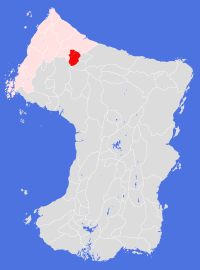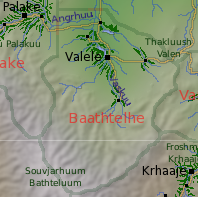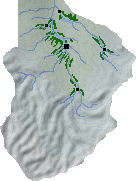Baathtelhe

Societal ties: Bartak
Current population: 1
Main language(s): Varam Bathtel
Area: 86,000km²
Natural and political borders
South and west - Souvjarhuum Bathteluum, including Mts. Turhein (6,150m), Ga'he (6,330m) and Bathtele (6,830m); South and east - the watershed between the Vaskuu and Albinuu river systems (Thakluush Valen).
The Land lays claim to all the river systems arising from the river Angrhuu south of latitude 43.0°N (agreed with Varhamyuuse) and east of longitude 163.5°E (agreed with Palake).
History
Alongside Palake and Tentole Plantations, Valele Plantation was part of the second stage of the planned expansion to accommodate refugees from the Tells region in Cheidrah. Unlike those other plantations, Valele proved to be difficult to establish - seed soils bought from Cheidrah quickly turned sour and the adaption of Defe seed soils took time. Valele settlement didn't begin to accept new settlers until gt569, 13 orbits after Palake.
In the event, other settlements and plantations proved to be more popular with settlers, and Valele's growth rate was slow. The plantation was beset with soil sourings for much of its first century and the city that grew up in the midst of the plantation had a widespread reputation for offering little more than a difficult life. Nevertheless, its position between Palake and Defe made the city a useful stopover for traders and administrators, and the plantation never failed completely. Valele was a founding member of the Bartekol League in gt720, and became a Land within the League as part of the New Agreement in gt751.
Prosperity did finally come to the Land in the mid tenth century. Small-scale mining had taken place in the Thakluush Valen since the early seventh century; with the technological growth of surrounding Lands came a demand for rarer metals and silicates. While these were not the richest deposits on the continent, they were conveniently close to the large cities driving the technological recovery. A new settlement was established in the east of the Land in gt941, and the mines continue to this day to generate significant revenues for the Land.

Politics and economy
For most of its existence Baathtelhe has operated as a single communitarian state, with no formal body being given a democratic mandate to make political or economic decisions on behalf of the rest of the population. Instead, issues are debated and determined through a series of continuous debates in which the whole population can take part. In times of crisis, the population have agreed to elect a person or group of people to deal with the emergency, but their power has always been limited. Population increases over the past 3 decades have made this system of government more difficult to operate, and debate continues within the Land about moving towards more formal structures.
A series of basic laws do exist, together with a set of punishments for transgressors, and there is a dedicated body of 'independent' judges tasked with keeping the peace - though again the actual role of a judge can seem to be somewhat fluid. Religious leaders often take on the role of judges on an informal basis, and most disputes are dealt with within the family or temple. Secular judges are most commonly found in the city.
The Land's economy is strongly dependent on mining activities - little agricultural produce is exported and there is little in the way of Type One life product to be harvested in the region. A more recent revenue stream has been the production of energy from hydroelectric sources: electricity is exported to both Palake and Varhamyuuse.
Baathtelhe does not have its own currency; coin minted in Palake and Varhamyuuse is considered to be legal tender throughout the Land.
Culture and other issues of interest
Baathtelhe folk are considered by outsiders to be rather dour and serious, with a rather basic and rustic sense of humour. Most are actively religious, with the Sky God enjoying particular popularity. Indeed much of the social dimensions of Baathtelhe life revolve around the temples, with temple elders settling disputes and arranging collective action in their neighbourhoods.
Alongside the formal religious practices coexist some rather strange folkloric beliefs concerning spiritual entities - giants and rock-creatures thought to live within the earth and the mountains. Given the difficulty of successfully cultivating the land compared to neighbouring areas, such beliefs are understandable - even if they do reinforce the stereotype of the population. The eastern mines are particularly rich sources of such stories.
Key natural features
The Bathtele mountain range in the south dominates this Land - indeed the highest peaks in the north of the continent form part of its southwestern border with the Pentuuk Land of Ohfalhe. From these mountains arise the Vaskuu river system which, together with the Vaskuu lakes, forms the heart of the Land. 465km separate the northern border and the southern peaks.

Habitats
The northern quarter of Baathtelhe falls within the Northern Valley habitat, within which all bar one of the Land's cultivations are found. Surrounding the Vaskuu valley are Northern Scrublands, while the Northern Mountains rims the southernmost areas.
Plantations and settlements
Cultivating the Vaskuu Valleys and lakes has proven to be a difficult, arduous task and the people of the Land have suffered several setbacks over the course of centuries. Nevertheless, they have succeeded: Valele Plantation extends some 250km along the course of the Vaskuu river. The plantation supports the city of Valele in addition to three other settlements. A fourth settlement has been established more recently in the west of the Land, importing seed soils from Palake to achieve the task of cultivating the Scrubland.
Key towns and cities
Rural population: 0 (0.0% of total)